![]()
![]()
![]()
Use LEFT and RIGHT arrow keys to navigate between flashcards;
Use UP and DOWN arrow keys to flip the card;
H to show hint;
A reads text to speech;
125 Cards in this Set
- Front
- Back
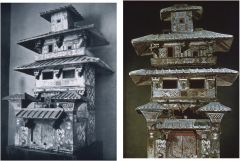
|
Name: Tomb model of a house
Medium: painted earthenware Period: Han Dynasty Small-scale clay models of Han architecture used as burial substitutes. They were found in large tombs, an afterlife dwelling for the dead. Model house, is of gray clay covered with white slip painted with red pigments, and some green lead glazed. The palace is simply such a building, made up of a number of the highest and largest possible bays put together. Decorations were important and were achieved with inlays of metal, precious stone, and jade, or with colorful paint and lacquer. |
|
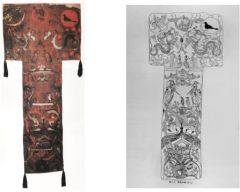
|
Name: Painted banner from the tomb of Lady Dai
Period: Western Han Date: after 168 BCE Medium: silk with colored pigments (Mawangdui Tomb 1, Hunan Province) Silk banner found draping the inner coffin is accomplished in technique and complex in design. Its formal and balanced composition depicts the three world levels: 1) the sky above with its mythical inhabtants (Sun Crow, moon toad, and celestial dragons) 2) the earth in the middle with the marquise and her women attendants 3) the nether regions with a burial grouping of ritual vessels and male (mourner?) figures supported on serpentine beasts and earth spirits This hanging painting gives us some inkling of the appearance of the large palace murals mentioned in Han literature. |
|
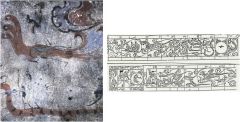
|
Name: Journey in the afterlife
Location: ceiling beam painting from the tomb of Bo Qianqiu and wife Period: Western Han Dynasty, middle of 1st century BCE (near Luoyang, Henan Province) Bo Qianqiu and his wife journey into the afterlife seeking immortality from the Queen Mother of the West. |
|

|
Name: Jade suit of Liu Sheng
Period: Western Han Date: ca. 113 BCE Medium: jade with gold thread (Mancheng, Hebei Province) 2500 pieces of jade sewn together, believed to prevent bodily decay. |
|

|
Name: Incense burner from the tomb of Liu Sheng
Period: Western Han Date: ca. 113 BCE Medium: bronze with inlaid gold (Mancheng, Hebei Province) The gold inlaid bronze censer with its pierced lid of mountain inhabited by birds, animals, and huntsmen surely embodies aristocratic taste for elegant technique, sophisticated representation, and knowing symbolism. Smoke from incense burner creates a fog, the way real mountains do. |
|
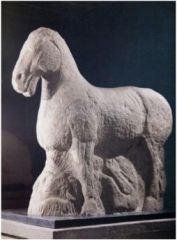
|
Name: Sculpture of a horse trampling a barbarian from the tumulus of Huo Qubing
Period: Western Han Date: ca. 117 BCE Medium: stone (Shaanxi Province) Large, formal sculptural monuments like these use crude naturalism with occasional memories of the late Animal style. The sculpture of a horse with an incidental figure of a man at this tomb is slightly contained within the stone block. The direct realism of the horse is modified by more formal considerations. The ribs of the man and the muscles of the horse's legs are indicated by grooving rather than by modeling and relief. |
|
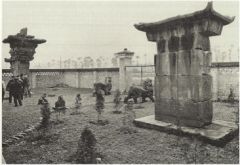
|
Name: Que gate towers and chimera
Period: Eastern Han Date: 209 CE Medium: sandstone (from the graveyard of Gao Yi, Sichuan Province) |
|

|
Title: Seated Buddha
Location: Binyang Cave at Longmen Caves Time Period: N. Wei, ca. 523(Henan Province) |
|
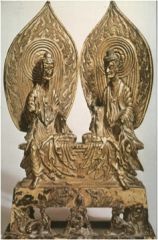
|
Title: Buddhas of the present and past (Shakyamuni and Prabhutaratna, from the Lotus Sutra)
Time Period: N. Wei, 518 CE Medium: gilt bronze Altar piece represents the meeting of the two Buddhas, Shakyamuni, the historical Buddha, and Prabhutaratna. The story of the scene is related in the lotus sutra. The Shakyamuni, seated on the vulture peak, had begun to expound the Buddhist law as it is presented in the lotus sutra. |
|

|
Title: Buddhist stele
Time Period: Northern and Southern Dynasties Date: 554 CE Medium: grey limestone One element of style, the waterfall drapery, is here somewhat decadently executed. The figure of angels and demons and lions are carved in fully Chinese rhythmical style. The tablet is simple divided into registers and these are in turn divided into niches for figures, an arrangement by no means always symmetrical. The lower registers display Chinese motifs: a donor, horses, and chimeras or lions. The execution of landscape elements in this stone relief was particularly significant in the development of Chinese paintings. |
|
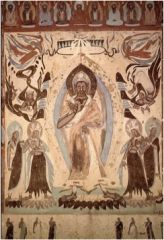
|
Title: Preaching Buddha
Location: Mogao Cave 249 Time Period: Northern Wei Dynasty, 5th century (Dunhuang, Gansu Province) Influance of Central Asia. These seem even more archaic than the sculptures, even to the point of caricature, though now the effect of oxidation and deterioration of pigments. Still, the artist has invested these figures with an almost frantic energy in his attempts to deal with such problems as the concept of modeling by light and shade. The result is more linear and energetic. |
|
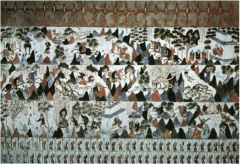
|
Title: Hungry Tigress jataka tale
Location: Mogao Cave 428 Time Period: Northern Zhou Date: ca. 550-575 CE (Dunhuang, Gansu Province) Buddha in his previous life throws himself to the tigers in order to feed them (shows he is self-sacrificing). |
|
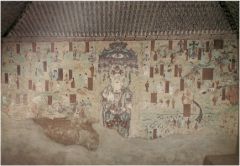
|
Title: Manifestations of Guanyin
Location: Mogao Cave 45 Time Period: Tang Dynasty, 8th century (Dunhuang, Gansu Province) |
|
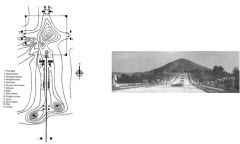
|
Title: Plan and view of Qianling, mausoleum of Emperor Gaozong and Empress Wu
Time Period: Tang Dynasty Date: ca. 683 CE (Shaanxi Province) |
|

|
Title: Great Buddha
Location: Fengxian Temple at Longmen Caves Time Period: Tang Dynasty Date: completed ca. 675 CE (Henan Province) The supreme Buddha, flanked by disciples, bodhisattvas, and guardians is about 44 ft tall and opposing full bodies figures and skillfully and sensitively carved despite their colossal size. Empress Wu contributed a lot of money. |
|
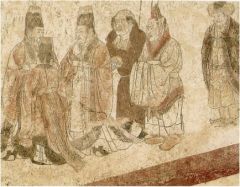
|
Title: Tang officials and foreign emissaries
Location: tomb of Prince Zhuanghuai Time Period: Tang Dynasty Date: ca. 706-711 CE (Shaanxi Province) |
|
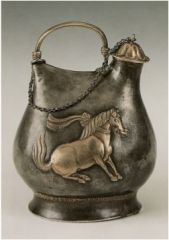
|
Title: Flask with dancing horse
Time Period: Tang Dynasty 8th century Medium: silver with repoussé gilt decoration THe shape of the vessel echoes a leather flask carried by Turkic peoples of central Asia. In technique it refelcts the silverworking tradition of Sasanian Iran; while gracefully maintaining the pose most unnatural to horses, the horse is holding between his teeth a footed wine cup. Tang texts record horses from the emperor's vast stables who were trained to dance while holding and occasionally drinking from cups of wine. |
|
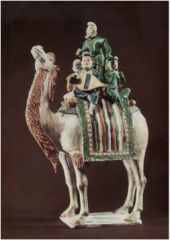
|
Title: Musicians and entertainers on a camel
Time Period: Tang Dynasty, Medium: sancai-glazed stoneware |
|
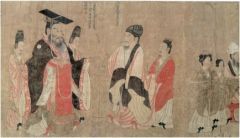
|
Artist: Yan Liben
Title: Emperors of the Successive Dynasties Time Period: Tang Dynasty 7th century (11th century copy) Type: handscroll Medium: ink and color on silk |
|
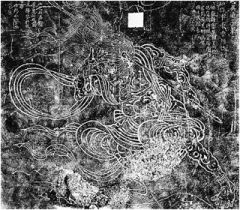
|
Artist: Wu Daozi
Title: Flying Demon Medium: ink rubbing from a stone engraving Time Period: Tang Dynasty, 8th century (Hebei Province) |
|

|
Artist: Zhou Fang
Title: Court Ladies Wearing Flowered Headdresses Time Period: Tang Dynasty, 8th century Type: handscroll Medium: ink and color on silk |
|
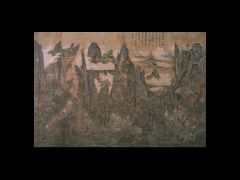
|
Artist: Li Zhaodao
Title: Emperor Minghuang’s Journey into Shu Period:Tang Dynasty, 7th century (10th-11th century copy) Type: hanging scroll Medium: ink and color on silk |
|
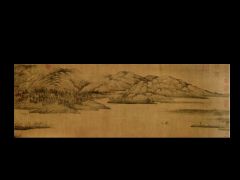
|
Artist: Dong Yuan
Title: Xiao and Xiang Rivers Period: Ten Kingdoms Period first half of 10th century Type: handscroll Medium: ink and color on silk |
|
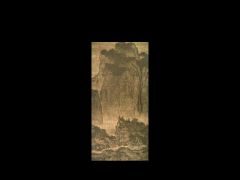
|
Artist: Fan Kuan
Title: Travelers Among Mountains and Streams Period: Northern Song Dynasty ca. 1000 Type: hanging scroll Medium: ink on silk |
|
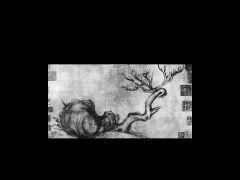
|
Artist: Su Shi
Title: Withered Tree and Strange Rock Period: N. Song late 11th century Type: handscroll Medium: ink on Paper |
|
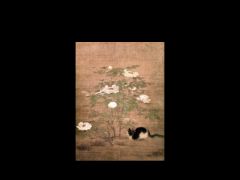
|
Anonymous
Title: Peonies and Cat Period: N. Song, 12th century Type: hanging scroll Medium: ink and color on silk |
|

|
Artist: Zhang Zeduan
Title: section of Spring Festival along the River Period: Northern Song 11th-12th century Type: Handscroll Medium: ink and colors on silk |
|
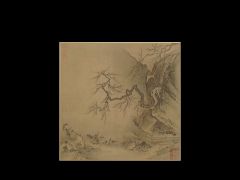
|
Artist: Ma Yuan
Title: Drinking in the Moonlight Period: S. Song late 12th-early 13th century Type: hanging Medium: ink and light color on silk |
|
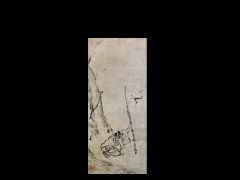
|
Artist: Liang Kai
Title: The Sixth Chan Patriarch Chopping Bamboo Period: S. Song early 13th century Type: hanging scroll Medium: ink on paper |
|
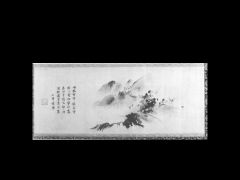
|
Artist: Yujian
Title: Mountain Market in Clearing Mist Period: S. Song mid-13th century Type: hanging scroll Medium: ink on paper |
|
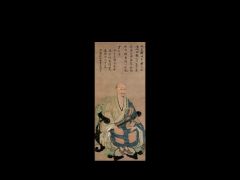
|
Anon.
Title: Portrait of Wuzhun Shifan Period: S. Song Date: 1238 Type: hanging scroll Medium: ink and color on silk |
|
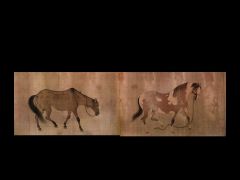
|
Artist: Ren Renfa
Title: Lean and Fat Horses Period: Yuan Dynasty, late 13th-early 14th century Type: handscroll Medium: ink and colors on silk |
|
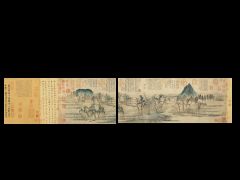
|
Artist: Zhao Mengfu
Title: Autumn Colors on the Qiao and Hua Mountains Period:Yuan Dynasty Date: 1296 Type: handscroll Medium: ink and color on paper(painted for Zhao Mengfu’s friend Zhou Mi) |
|

|
Artist: Shen Zhou
Title: Lofty Mount Lu Period: Ming Dynasty Date: 1467 Type: hanging scroll Medium: ink and color on paper |
|
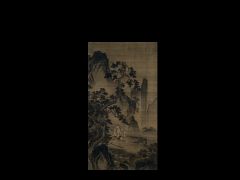
|
Artist: Dai Jin
Title: The Hermit Xu You Resting by a Stream Period: Ming Dynasty Type: hanging scroll Medium: ink and color on silk Depicts a legendary Confucian worthy famous for his refusal of the throne and of high office, resting beneath a Ma Yuan-type pine tree in a very strongly of brushed vertical landscape. the interweaving of brush strokes and images produces powerful and decorative forms in a somewhat flattened space-particularly well suited to Confucian iconography meant to be seen at a distance in a somewhat formal setting. |
|
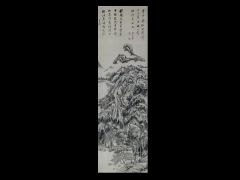
|
Artist: Dong Qichang
Title: The Qingbian Mountains Period: MingDynasty Date: 1617 Type: hanging scroll Medium: ink on paper |
|
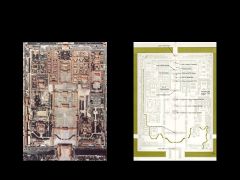
|
Title: Aerial view and plan of the Forbidden City
Place: Beijing Built in 1406 (Ming Dynasty) Date: rebuilt in mid-17th century (Qing Dynasty) (for reference only) |
|
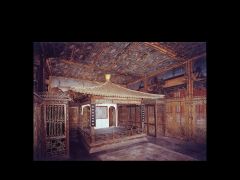
|
Title: Lodge of Retiring from Hard Work (Repose and Longevity Palace Complex)
Period: Qing Dynasty 18th century Location: Forbidden City, Beijing |
|
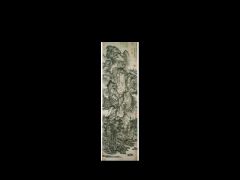
|
Artist: Wang Meng
Title: Dwelling in Reclusion in the Qingbian Mountains Period: Yuan Dynasty Date:1366 Type: hanging scroll Considered the most monumental of all of Yuan landscapes, the combination of rich brushwork, undulating contours, grand scale, and size is unforgettable. Wang Ming is recognized as one of the giants of the Wenren tradition. Medium ink on paper |
|
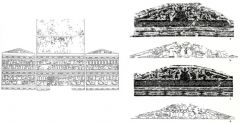
|
Title: Queen Mother of the West and King Father of the East
Location: Wu Liang Shrine Period: E. Han mid-2nd century CE Medium: ink rubbing from stone slabs (Shandong Province) |
|
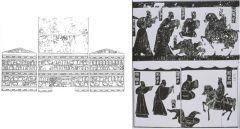
|
Title: Story of the Righteous Stepmother of Qi
Location: Wu Liang Shrine Period: E. Han mid-2nd century CE Medium: ink rubbing from stone slabs (Shandong Province) |
|
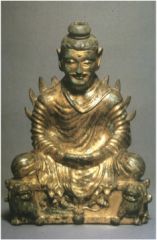
|
Title: Seated Buddha
Date: ca. 300 CE Medium: gilt bronze |
|
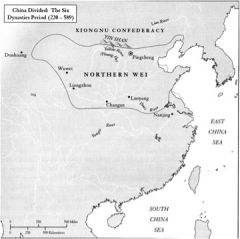
|
Map of Northern Wei territory (for reference)
|
|
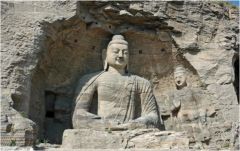
|
Title: Colossal Buddha
Location: Yungang Cave 20 Period: N. Wei Date: ca. 460-480 CE (Shanxi Province) Carved into living rock. Drapery is derived from Bamiyan string patterns and the face shows traces of Gandhara style. |
|

|
Title: Bodhisattva and disciples
Location: Yungang Cave 18 Period: N. Wei Date: ca. 460-480 CE (Shanxi Province) |
|
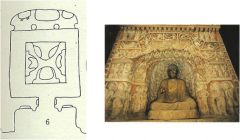
|
Title: Seated Buddha in central pillar of Yungang Cave 6
Period: N. Wei Date: completed 494 (Shanxi Province) |
|
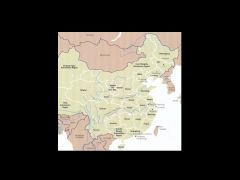
|
Map of China (for reference)
|
|
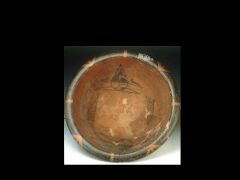
|
Title: Basin
Period: Yangshao culture (Banpo phase) Date: 5th millennium BCE Medium: earthenware with slip Painted with black-on-red designs of geometric figures, human masks, fish, and occasionally animals. |
|
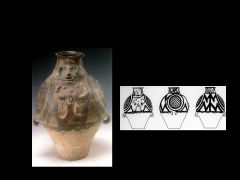
|
Title: Jar
Period: Yangshao culture, (Machang phase) Date: late 3rd millennium BCE Medium: earthenware with slip Raised figure on jar. If female, would mean matriarchal society, male patriarchal, androgenous might mean unity of the sexes. |
|
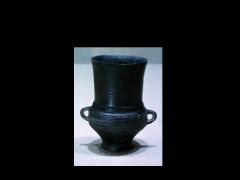
|
Title: Jar
Period: Longshan culture Date: 3rd millennium BCE Medium: “eggshell” ware |
|
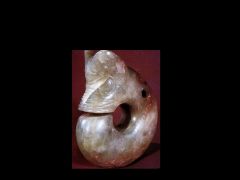
|
Title: Pig-dragon
Period: Hongshan culture Date: 4th millennium BCE Medium: jade |
|

|
Title: Cong tube
Period: Liangzhu culture Date: 3rd millennium BCE Medium: jade From imported jade boulders large rectangular prisms with cylindrical inner surfaces (cong) were carved, then decorated with rectilinear patterns. These were further embellished with engraved interlace spirals and circles, often defining eye, nose and mouth "masks" which were to become major elements in the Shang iconographic vocabulary |
|
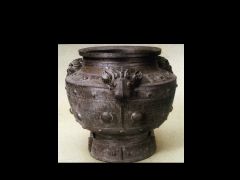
|
Title: Ritual vessel
Period: Shang Dynasty, (Erligang phase) Date: 15th-14th centuries BCE Medium: bronze |
|
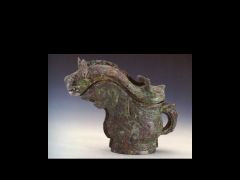
|
Title: Ritual vessel
Period: Shang Dynasty, (Anyang period) Date: ca. 1200 BCE Medium: bronze Location: (from Fu Hao’s tomb) |
|
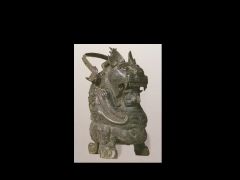
|
Title: Ritual vessel
Period: Shang Dynasty, (Anyang period) Date: first half of the 11th century BCE Medium: bronze A very complicated vessel in the form of a bear or a tiger squatting on its haunches, with its tail used as a third support, and surmounted by a deer on its head. Clutched in the forelegs and maw of the beast is the figure of a man with his head turned sideways. Whether this is a representation of the perils of the hunt or whether this is a representation, of the eclipsing sun as devourer, depends largely on one's disposition to believe in the universality of these myths |
|
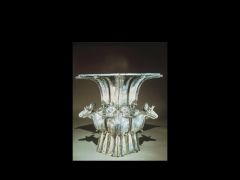
|
Title: Ritual vessel
Period: ate Shang Dynasty Medium: bronze Location: (excavated in Ningxiang County, Hunan Province) |
|
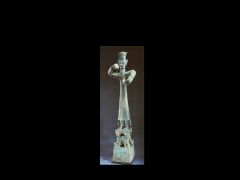
|
Title: Standing figure from Sanxingdui
Date: ca. 1200-1000 BCE Medium: bronze (Sichuan Province) Life-sized standing figures of totemic or shamanistic type. The cast designs on their costumes include masks and animals clearly related to the designs on jades and bronzes. |
|
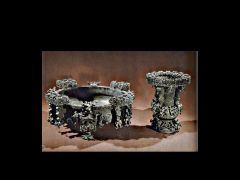
|
Title: Water basin and wine vessel from the tomb of Marquis Yi of Zeng E. Zhou
(Warring States Period) Date: early 5th century BCE Medium: bronze |
|
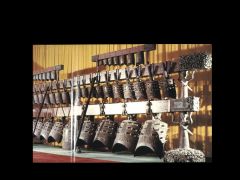
|
Title: Set of chime-bells from the tomb of Marquis Yi of Zeng
E. Zhou (Warring States period) Date: early 5th century BCE Medium: bronze and lacquered wood Each bell could sound two different notes, one if struck at the side, the other at the center. Their shapes were increasingly refined and their subtle elliptical cross sections carefully calculated to produce precisely the desired tones. Currently the most famous of such bells are the sixty-five buried in the tomb of Marquis Yi of Zeng still suspended from their frame. This group was assembled from at least three different carillons, and includes a single bo bell unrelated to either. |
|
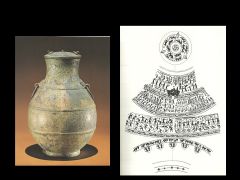
|
Title: Vessel
Period: E. Zhou Date: late 6th-5th centuries BCE Medium: bronze with lost inlay |
|
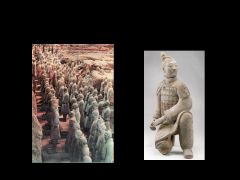
|
Title: Terracotta soldiers from the mortuary complex of the First Emperor of Qin
Period: Qin Dynasty Date: ca. 210 BCE Medium: earthenware (Shaanxi Province) > 7000 life-sized gray clay figures of warriors and horses found in military position guarding the tomb of Qin Shi Huang Di |
|
|
axe-cut stroke
|
Ex: Li Tang, Ma Yaun, Xia Gui
|
|
|
Ma-Xia style
|
...
|
|
|
Ch. Chan / J. Zen / Skt. Dhyana
|
...
|
|
|
Bodhidharma
|
Mt. Song
Shaolin Monastery |
|
|
Loess clay
|
a fine-grained unstratified accumulation of clay and silt deposited by the wind
|
|
|
Earthenware
|
ceramic ware made of slightly porous opaque clay fired at low heat
|
|
|
Stoneware
|
a strong opaque ceramic ware that is high-fired, well vitrified
|
|
|
Slip
|
water down clay with color
a clay solution of creamy consistency for coating or decorating biscuit |
|
|
Pig-dragon
|
named To describe the object
Coil body suggest dragon Nose suggest pig |
|
|
Bi Disk
|
Large flat slat with a hole in the middle
Heavy so not warn as personal ornaments |
|
|
Cong tube
|
Tube with a square cross section
Found in burials arranger around the deceased |
|
|
Yin
|
Last capital city of the Shang Dynasty
|
|
|
Taotie mask
|
Decorative motives with no meaning or symbolic religious icon ??
Restricted for ritual uses Animal like or represented real animals ?? |
|
|
Pottery-Shaping Techniques
|
Slab-forming
coiling wheel-throwing |
|
|
Nephrite
|
Type of jade
|
|
|
piece mold
|
Clay pressed into a mold until hardened to create an object
|
|
|
Lost wax casting
|
Bronze cast created - hot wax is poured into the cast and hardens to create the desired object
|
|
|
inlay
|
Fitting a solid colored substance into the cavity of a piece.
|
|
|
Relief/intaglio
|
print-making
|
|
|
taotie mask
|
monster mask commonly found bronze Chinese ritual vessels
|
|
|
leiwen pattern
|
pattern found on Chinese vessels
|
|
|
Yin
|
the last capital city of the Shang Dynasty
|
|
|
Sanxingdui
|
Bronze Age archaeological site in China
|
|
|
mingqi
|
spirit artifacts
|
|
|
Tuoba
|
a clan of Xianbei people from the early centuries of the first millenia CE
|
|
|
samsara
|
sanskrit - rebirth
|
|
|
karma
|
the idea that what you do in life will affect your rebirth and next life
|
|
|
Yungang Caves
|
Ancient Buddhist Chinese temples famous for their rock-cut architecture
|
|
|
Longmen Caves
|
Buddhist temples spread out on two mountains, separated by the Yi River
|
|
|
Vairocana Buddha
|
cosmic Buddha
|
|
|
stupa
|
place of Buddhist prayer
|
|
|
pagoda
|
tiered tower with multiple eaves
|
|
|
stele
|
an upright stone or slab with an inscribed or sculptured surface
|
|
|
Mogao Caves
|
Caves of a Thousand Buddhas
|
|
|
bodhisattva
|
teacher who refrains from entering Nirvana in order to teach others how to do so
|
|
|
apsaras
|
super-naturally beautiful women
|
|
|
Lotus Sutra
|
a discourse by the Buddha before the end of his life
|
|
|
Universal Gateway Chapter
|
Chapter 25 of the Lotus Sutra
|
|
|
expedient means
|
upaya, like a goal, brings someone up from something
|
|
|
sancai
|
three color
|
|
|
arhat
|
lohan - someone who has realized Nirvana and will not be reborn
|
|
|
hanging scroll
|
vertical scrolls
|
|
|
handscroll
|
horizontal scrolls
|
|
|
dian
|
dots
ex. Dong Yuan |
|
|
cun
|
texture strokes
|
|
|
hemp-fiber strokes
|
ex: Dong Yuan, Juran
|
|
|
monumental landscape
|
ex: Fan Kuan, Guo Xi
|
|
|
shiren hua
|
scholar's painting or literati painting
ex. Su Shi, Wen Tong, Li Gonglin, Mi Fu, Mi Youren |
|
|
baimiao
|
plain drawing - applies to paintings of human figures or animals
ex. Li Gonglin |
|
|
Mi-dots
|
ex: Mi Fu, Mi Youren
|
|
|
boneless style
|
ex: Mi Fu, Mi Youren
|
|
|
jiehua
|
ruled-line painting, applies to paintings of architecture or boats
ex: Zhang Zeduan |
|
|
Bodhidharma
|
Mt. Song, Shaolin Monastery
|
|
|
satori
|
sudden enlightenment
|
|
|
The Shrimp Eater
|
Xianzi
|
|
|
Guanyin (J. Kannon)
|
Mt. Potalaka
|
|
|
haboku
|
splashed ink
ex: Yujian |
|
|
chinso
|
monk's portrait
|
|
|
yimin
|
leftover citizen
|
|
|
chaoyin
|
recluse at court
|
|
|
pingdan
|
plainness
|
|
|
Wu School
|
based in Suzhou - Shen Zhou
|
|
|
Zhe School
|
based in Zhejiang Province - Dai Jin
|
|
|
Four Great Masters of the Yuan Dynasty
|
Huang Gongwang
Ni Zan Wu Zhen Wang Meng |

